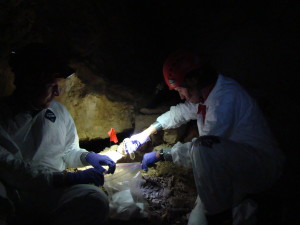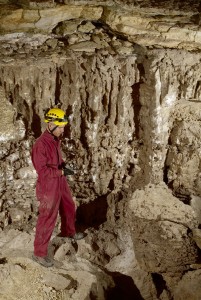
ST. GEORGE – The antibiotic that saves your life or the cure for a disease that has already killed millions of bats may come from caves in the Arizona Strip in Mohave County, Arizona.

Researchers have been studying microbes found on cave walls and on bats found in caves in the Grand Canyon-Parashant National Monument in Arizona.
“At Parashant, we are getting things that are so novel, we can only classify them down to order, not even to family,” Diana Northup said. “This is like being able to say, ‘it’s a mammal’ and that’s it.”
Northup is a professor at the University of New Mexico and the head of SLIME, or Subsurface Life in Mineral Environments, a team formed to study cave-dwelling microbes.
Northup studies microbes that live on bats and on cave walls and has been culturing bacteria that live on bats by capturing and swabbing the bats. Of particular interest is the actinobacteria, a source of two-thirds of the natural antibiotics used by humans.
“Most of these organisms that we find are ones that have never been described by science before,” Northup said.
Researchers are also testing bacteria found on bats to see if it’s effective in fighting the fungus that causes white-nose syndrome, a fungus-caused disease that has killed millions of bats in eastern and midwestern United States.

White-nose syndrome is spreading westward, but so far bats in the Southwest are not infected, Northup said. However, the disease has recently been found in Nebraska and Oklahoma, and the U.S. Fish and Wildlife Service confirmed a case of white-nose syndrome in Washington state March 31.
The fungus that causes white-nose syndrome originated in Europe and is believed to have killed bats there thousands of years ago. Fungi are airborne, and cause a skin infection in bats.
Typically the fungal infection causes bats to wake up from winter hibernation to groom, which depletes stored energy reserves and causes the bat to starve to death before spring arrives, Northup said.
“We’re hoping that by looking at bats that do not have white-nose yet, we can establish a valuable baseline of (what microbes) lives on it (sic),” she said.
It is now known that most bacteria that live on humans and animals and form the microbiome are not dangerous but actually contribute to health.

One of the best inhibitors of the fungus that causes white-nose syndrome that has been found so far came from the Grand-Canyon-Parashant National Monument, Northrup said.
According to Bat Conservation International, preserving bat populations is critical due to the role the animals play in insect control, pollination, seed-spreading and fertilizer production.
Northup also studies organisms that live in the biofilm on cave walls. Some microbes make rocks by taking elements like manganese, sulphur or iron and gaining energy by converting them to the oxidized form. In the process, some of the microbes make rocks like carbonate, and others excrete fluids that dissolve rock.
One of the most exciting reasons to study cave microbes is for the search for extraterrestrial life, Northup said.
“We now know that Mars and the moon and many other extraterrestrial bodies have lava caves on them,” Northup said. “It’s much more likely that if we’re going to find life in our solar system or beyond that, that life is going to be in the subsurface in one of those lava caves.”
Resources
- U.S. Fish and Wildlife Service white-nose syndrome website
- Subsurface Life in Mineral Environments, or SLIME
- Bat Conservation International website
Click on photo to enlarge it, then use your left-right arrow keys to cycle through the gallery.

A scientist studies microbes and bats in a cave in the Grand Canyon-Parashant National Monument, date unspecified | Photo courtesy of Grand Canyon-Parashant National Monument, St. George News

Scientists study microbes and bats in a cave in the Grand Canyon-Parashant National Monument, Arizona, date unspecified | Photo courtesy of Grand Canyon-Parashant National Monument, St. George News

A scientist works in a cave in the Grand Canyon-Parashant National Monument, Arizona, date unspecified | Photo courtesy of Grand Canyon-Parashant National Monument, St. George News
Email: [email protected]
Twitter: @STGnews
Copyright St. George News, SaintGeorgeUtah.com LLC, 2016, all rights reserved.

